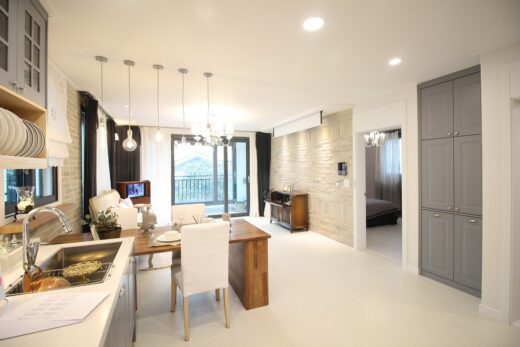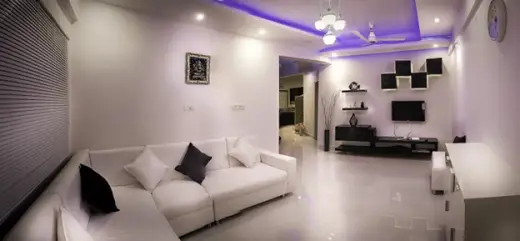Improving lighting in your home, a how-to guidee, Light trend advice, Property interior design style
Improving Lighting in Your Home: A How-to Guide
17 May 2024
Are your eyes constantly straining to see properly or do you struggle with finding the right lighting for different tasks? You’re not alone. Many people overlook the importance of proper lighting in their homes, resulting in uncomfortable and inefficient living spaces. But fear not, this comprehensive how-to guide is here to help.
In this blog post, we will delve into the world of home lighting and explore everything from its impact on our daily lives to practical tips on how to improve it for a brighter and more functional home. Let there be light!
Invest in Lighting Fixtures
The first step in improving your home’s lighting is to invest in good-quality fixtures. Some common light fixtures may include overhead lights, lamps, and task-specific lighting such as under-cabinet lights or reading lights. Before making your selection, know that you should take both aesthetics and functionality into account.
A statement chandelier or pendant light can add a touch of elegance to your living room while providing ample ambient light. Lamps can also serve as both an aesthetic and functional addition to any room, allowing you to adjust the lighting for different activities. For task-specific lighting, make sure to choose fixtures that are specifically designed for the intended purpose, whether it’s cooking in the kitchen or reading in bed.
Maximize Natural Light
The best source of light is often the most overlooked: natural light. Apart from providing ample illumination, it also improves our mood and overall well-being. So don’t be afraid to open up those curtains and let the sunshine in.
To maximize natural light in your home, consider adding larger windows or skylights if feasible. If not, you can also strategically place mirrors to reflect natural light into darker areas of your home. Know that the color of your walls and furniture can also affect the amount of natural light in a room, so choose lighter colors to maximize brightness.
Layer Your Lighting
Instead of relying on one source of light, consider layering your lighting for a more dynamic and versatile space. Use a combination of ambient, task, and accent lighting to create different moods and cater to various needs.
Ambient lighting provides overall illumination for a room and can be achieved with ceiling lights or evenly spaced wall lights. Task lighting, as the name suggests, is meant for specific tasks and should be directed towards the area where the task will take place. Accent lighting is used to highlight specific features or objects in a room, such as artwork or architectural details.
Utilize Dimmers
Integrating dimmers into your lighting setup is a game-changer for creating a customizable ambiance in any room. Dimmers allow you to adjust the brightness of your lights to match the time of day, activity, or mood. For instance, a brightly lit kitchen is essential for cooking, but softer lighting can enhance the dining experience.
Most importantly, dimming lights can lead to energy savings, reducing your household’s electricity consumption and overall utility bills. Just imagine the possibility of having complete control over your home’s lighting.
Upgrade to LED bulbs
If you’re still using incandescent or fluorescent bulbs, it’s time for an upgrade. LED (light-emitting diode) bulbs are more energy-efficient and have a longer lifespan than traditional bulbs. They also come in various colors and can be dimmed, making them perfect for creating a personalized lighting experience.
LED bulbs may be more expensive upfront, but the energy savings and longer lifespan make them a worthwhile investment in the long run. Plus, you’ll never have to worry about constantly changing burnt-out light bulbs again!
Use Reflective Surfaces
Mirrors, glass tables, and glossy finishes can all bounce light around a room and make it feel brighter. This is especially useful in smaller or darker rooms where natural light may be limited. Just like with layering your lighting, be intentional with where you place these reflective surfaces. Placing a mirror opposite a window, for example, can effectively double the amount of natural light in a room. Or, consider adding a glass coffee table to reflect light from overhead fixtures.
In this digital age, there’s an app for everything — even controlling your home’s lighting. Consider investing in smart lighting solutions that allow you to control your lights from your smartphone or with voice commands. These systems often come with customizable settings, timers, and the ability to control multiple lights at once.
Proper lighting is crucial for creating a comfortable and functional home. By investing in good-quality fixtures, maximizing natural light, layering your lighting, utilizing dimmers, upgrading to LED bulbs, and using reflective surfaces, you can significantly improve the lighting in your home. Additionally, smart lighting solutions offer convenience and customization options that make managing your home’s lighting easier than ever before. Say goodbye to straining your eyes and hello to a brighter and more efficient home!
Comments on this guide to Improving Lighting in Your Home: A How-to Guide article are welcome.
Lighting Articles
Lighting Posts
Getting your home filled with light

How Lighting Influences Mood and Productivity

image source : pixabay.com
Tips To Choose the Right Lighting for Your Home
Best Solar Light Manufacturers In China
How to Use Lighting, Space and Material in Architectural Design
Welding
Welding Machines and Welders
How to choose a welding machine
Why is safety important in welding?
MIG Welding tips for home builders
Building Articles
Residential Architecture
Comments / photos for the Improving Lighting in Your Home: A How-to Guide page welcome



